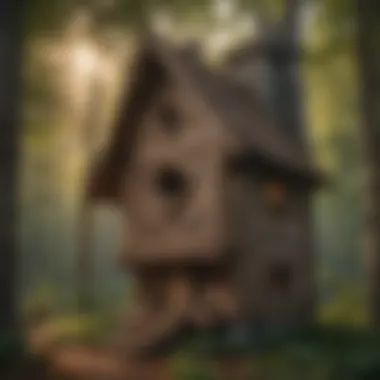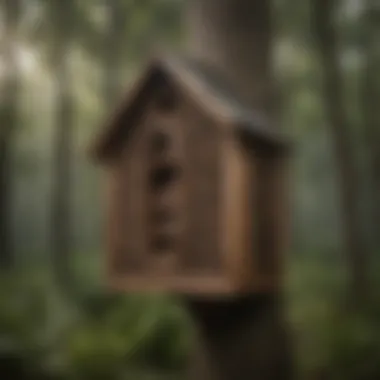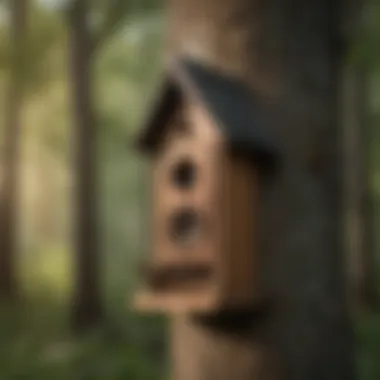Creating a Sustainable Bat House for Ecological Balance


Intro
The construction of bat houses resonates deeply within the realms of ecology and biodiversity. Bats serve as vital components in many ecosystems; their roles as pollinators and pest controllers cannot be overstated. This article will dissect the multifaceted process of building an effective bat house. We will delve into not just the construction, but also address placement, maintenance, and the broader ecological implications of bats.
Understanding the connection between bat populations and environmental health will guide our exploration. Bats, often misunderstood, are crucial in sustaining natural landscapes. In essence, this guide aims to promote awareness about bats and provide actionable steps toward their conservation through thoughtful bat house construction.
Understanding Woodland Ecosystems
Bats occupy a unique niche within woodland ecosystems. They are inherently tied to the health of the forests around them. Understanding this relationship requires an appreciation of the broader ecological context.
Importance of Biodiversity in Forests
Biodiversity is the backbone of forest ecosystems. Diverse biological communities enhance resilience, enabling ecosystems to adapt to changes and disturbances. Healthy bat populations contribute to this biodiversity, serving as indicators of overall environmental health. Research indicates that areas with varied bat species often exhibit robust insect populations, indicating a balanced ecosystem.
- Bats assist in the pollination of various plants.
- They help control insect populations that threaten forestry health.
Role of Forests in Climate Regulation
Forests play a critical role in climate regulation. They sequester carbon dioxide, regulating atmospheric levels of greenhouse gases. Bats, in their nightly foraging, also contribute by consuming vast amounts of insects that could otherwise damage forest health. The relationship between bats and forests forms a cycle that supports the integrity of woodlands.
"Healthy forest ecosystems, populated with diverse species including bats, are fundamental for climate stability and ecological resilience."
Sustainable Forestry Practices
When constructing bat houses, incorporating knowledge of sustainable forestry is essential. Learn to balance ecological needs with modern practices to ensure long-term success.
Principles of Sustainable Forestry
Sustainable forestry encompasses the management of forest resources without compromising ecosystem integrity. This approach aligns well with bat house construction, as it supports habitats conducive to bat populations.
- Implementing selective logging helps maintain biodiversity.
- Promoting native plant species guarantees food sources for bats.
Case Studies of Successful Implementations
Several regions have demonstrated effective implementation of sustainable practices. For example, the Pacific Northwest has utilized selective logging techniques alongside bat conservation initiatives, showing how thoughtful management can benefit both bats and timber production.
Woodland Stewardship Techniques
Woodland stewardship is crucial for maintaining healthy ecosystems. These techniques ensure that bat habitats are protected while promoting overall forest health.
Forest Management Plans
A well-structured forest management plan outlines strategies for ecological sustainability. This includes considerations for bat habitats, such as preserving roosting areas and minimizing disturbances during breeding seasons.
Conservation Strategies
Engaging with local communities to foster bat conservation enhances the effectiveness of stewardship efforts. This includes educational programs that foster appreciation for bats and their ecological contributions. Involving the community can lead to successful conservation outcomes, as seen in various local initiatives worldwide.
By understanding and integrating these elements into the process of constructing bat houses, individuals can contribute positively to local ecosystems. The next sections will specifically address the practical aspects of bat house construction.
Foreword to Bat Houses
Constructing a bat house is more than just creating a shelter for bats; it is a meaningful endeavor that serves an ecological purpose. Bats are fascinating creatures with significant roles in our ecosystems. They help control insect populations, pollinate plants, and contribute to seed dispersal. Therefore, providing suitable housing for them can aid in sustaining healthy environments. This section introduces the reader to bats, their contributions to nature, and the pressing need for their conservation.
Understanding Bats and Their Importance
Bats are often misunderstood and sometimes feared. In reality, they are vital allies in maintaining ecological balance. There are over 1,400 species of bats, and they occupy various habitats across the globe. Many bats are nocturnal, which allows them to hunt insects at night when those insects are most active. This helps keep insect populations in check, reducing reliance on chemical pesticides.
Moreover, fruit-eating bats are essential for pollination. They contribute to the health of many plant species, including those that are economically important, like bananas and mangoes. By dispersing seeds, bats help in forest regeneration and maintaining biodiversity. Thus, understanding the ecological role of bats is crucial for emphasizing the benefits of bat houses.
The Necessity of Bat Conservation


Conservation of bats is becoming increasingly urgent due to various threats they face. Habitat destruction, climate change, and disease, particularly white-nose syndrome, have drastically reduced bat populations in many areas. Such declines can lead to imbalances in ecosystems, as the loss of bats affects not only insect populations but also other animals that rely on a healthy environment.
Creating bat houses is a proactive step toward aiding in conservation efforts. At a community level, individuals can contribute by erecting bat houses, thus providing bats with safe roosting spaces away from their natural habitats, which may be compromised. This action not only assists local bat populations but also promotes awareness about their ecological significance. Encouraging bat conservation is not merely an individual act; it is a community responsibility that entails fostering environments where bats can thrive.
"Bats play a critical role in our ecosystem, and their decline impacts us all. Building a bat house is one of the simplest yet most effective ways to contribute to bat conservation."
In sum, understanding bats and the necessity of their conservation provides a foundation for the importance of bat houses. This knowledge serves to motivate individuals to engage in actions that support local ecosystems while appreciating the unique qualities of these animals.
Design Considerations for Bat Houses
Designing a bat house requires careful thought and precision. This section emphasizes vital elements that affect the overall effectiveness of the bat house. Understanding the design considerations ensures that bats are attracted to the house and stay there long-term. Proper design can lead to not only successful habitation but also enhanced contributions to local ecosystems.
Materials You Will Need
Selecting appropriate materials is crucial in constructing a functional bat house. Here are some materials to consider:
- Wood: Untreated cedar or pine is ideal, as they resist rot and provide natural insulation. Avoid chemically treated wood since it can be harmful to bats.
- Screws and Nails: Galvanized or stainless steel fasteners will withstand the elements better and prevent rusting.
- Wood Glue: Used in conjunction with screws for additional stability and strength.
- Non-Toxic Paint (optional): If painting, choose non-toxic, water-based paints. Dark colors are preferable to absorb heat but should still allow the wood to breathe.
Additionally, a few basic tools will simplify the constructions process. These include a saw, hammer, screwdriver, and drill. Having the right materials and tools ensures a smoother building experience.
Dimensions and Size Recommendations
The dimensions of a bat house play a significant role in attracting bats. Bats prefer larger houses as they offer more space for roosting. For efficient bat houses, consider the following guidelines:
- Height: Minimum height should be 24 inches and widely suggested up to 36 inches. Taller houses attract various species of bats.
- Width: A width of 14 inches is ideal, allowing for multiple bats to roost side by side.
- Depth: A depth range of 4 to 6 inches is optimal, providing enough room without making it too cavernous.
In general, a larger entrance hole (1.5 inches in diameter) can accommodate various bat species. Proper dimensions will help ensure that the bats feel secure in their environment, encouraging them to return.
Ventilation and Access Points
Proper ventilation is essential for the success of a bat house. Without adequate airflow, the house can become too hot, especially in warm climates. Here are key points to consider:
- Ventilation Holes: Small holes or slots at the top of the house allow excess heat to escape while still maintaining a dark interior that bats prefer.
- Access Points: Ensure the entrance hole is positioned below the ventilation holes. This setup helps bats enter and exit safely.
As an important takeaway, maintaining a balance between ventilation and keeping the interior dark will create a more inviting environment for bats. These design considerations reflect care for the health and wellbeing of local bat populations, supporting wildlife conservation efforts.
By investing time into thoughtful design, you are not only creating a home for bats but contributing to a sustainable ecosystem that benefits the broader environment.
Step-by-Step Construction Guide
Completing a bat house project requires careful planning and execution. The Step-by-Step Construction Guide is central to this process as it breaks down the intricate tasks involved in building an effective and functional bat house. By providing structured guidance, enthusiasts can ensure that each aspect of construction is performed correctly, which significantly contributes to the habitat suitability for bats. Clear construction steps not only help in protecting these creatures but also encourage community involvement and education about local wildlife.
Gathering Tools and Materials
The first step in any construction project is to ensure that one has all necessary tools and materials. For building a bat house, the essential tools include:
- Measuring tape: For accurate dimensions.
- Saw: Typically, a circular or hand saw is best for cutting wood panels.
- Drill: To make holes for screws and ventilation.
- Screws and nails: For fastening the structure together.
- Sandpaper: To smooth wooden surfaces, reducing the chance of injury to bats.
In addition to tools, the correct materials are vital. The preferred wood types are cedar or plywood, as they resist decay. It is important to avoid treated wood, which may contain harmful chemicals affecting bats. Other materials required might include screws, nails, wood glue, and possibly a waterproof sealant to protect the bat house from the elements.
Building the Structure
Once tools and materials are secured, focus shifts to building the bat house structure. This is where measurements and initial cuts come into play. Begin by following the defined plans or dimensions, ensuring all pieces fit together. The basic steps include:
- Cut the base and sides: Precision in cutting the wood will ensure that the assembly aligns perfectly.
- Assemble the base: Use screws to join the base with the sides firmly.
- Top and lid fitting: Leaving room for ventilation is key, so the lid should not be fully sealed.
It is best to construct the bat house in a way that also allows for easy access for maintenance. Consider designing it with a hinged roof or removable side. This will enable future inspections and cleaning, which are part of the ongoing maintenance process.
Adding Interior Features
Adding specific interior features can enhance the usability of the bat house for its resident bats. Interior items such as roosting slots or roughened surfaces facilitate grip when bats enter and exit the house. Some considerations for improving the interior include:


- Creating multiple chambers: This can accommodate different bat species or increase the chances of occupancy.
- Rough surfaces (like wood slats): To enhance grip, place vertical slats along the interior walls.
- Ventilation holes: Proper airflow is essential to moderate the internal temperature of the house, making it inviting.
When implementing these features, ensure they do not compromise the overall structural integrity. A well-constructed bat house can provide a safe refuge and breeding place for these beneficial creatures.
Optimal Placement of Bat Houses
Proper placement is crucial when constructing a bat house. The location of the house can significantly affect whether bats will choose to inhabit it. Understanding the specific needs of bats in relation to their environment is necessary for ensuring their comfort and survival. A well-placed bat house not only encourages occupancy but also promotes the ecological benefits that these creatures provide, such as natural pest control.
Location and Environmental Considerations
When selecting a location for a bat house, several environmental factors should be taken into account. Bats prefer areas that provide ample shelter and food sources. For instance, choosing a spot close to water bodies, like ponds or streams, is advantageous as bats often forage around such habitats. The presence of flowering plants or trees nearby can also enhance the area's insect population, providing a food source for the bats.
Other considerations include how much sunlight the location receives throughout the day. Bat houses should typically be placed in sunny areas as warmth helps to regulate internal temperatures, thus attracting bats more effectively. However, avoiding direct sunlight during peak hours, especially in hotter climates, is also important to prevent overheating within the house.
Additionally, the surrounding landscape plays a role in determining attractiveness. Open fields or gardens are preferred over densely wooded areas, as these provide easier flight paths for bats to enter and exit.
Height and Orientation
The height at which a bat house is mounted is critical. Ideally, bat houses should be placed 12 to 20 feet above the ground. This height reduces the risk of predators, while also allowing bats to reach their roosting spots easily. Placement on structures like poles, buildings, or trees can also be considered, as long as the house is securely fastened and accessible.
Orientation is another undebatable aspect of optimal placement. A house facing south or southeast is preferred. This orientation exposes the house to the morning sun, which helps in warming it during those cooler early hours. It also helps in creating an inviting environment for potential residents.
Avoiding Potential Hazards
When planning the placement of a bat house, it is essential to identify and mitigate potential hazards. Nearby sources of chemical pesticides should be avoided. Pesticides can have detrimental effects on bat populations and also reduce their food supply. Keeping bat houses away from areas with heavy foot traffic can also help minimize disturbances.
Another danger is the presence of predators such as cats or birds of prey. To mitigate this, choose locations that are not easily accessible to these threats. Placing the bat house away from branches that might allow predators to gain access is wise.
Maintaining Your Bat House
Maintaining your bat house is essential for ensuring the health and safety of the bat population that it supports. Bats are sensitive creatures, and their living environments require attention. With the right maintenance, your bat house can become a thriving habitat that encourages bats to settle in and contribute positively to the local ecosystem. Regular maintenance preserves the structure and functionality of the bat house and helps create a suitable environment for the bats to thrive. Moreover, well-maintained bat houses can reduce human-wildlife conflict by minimizing the chances of bats finding alternative roosting spots, potentially within residential areas.
Regular Inspection Guidelines
Regular inspections are crucial to identify any potential issues early. Inspections should occur at least twice a year, preferably in the spring and late summer. During these inspections, check for the following:
- Structural integrity: Look for cracks, holes, or signs of wear that may require repair.
- Pest presence: Be aware of any insects that may have taken residence in or around the bat house, such as wasps or bees.
- Fungal growth: Damp interiors can encourage mold or mildew, which can harm bats. Ensure the house is ventilated and dry.
After conducting an inspection, document your findings. This documentation can provide insight into ongoing issues or the success of your maintenance strategies.
Cleaning and Repairs
Cleaning the bat house is necessary to maintain a healthy living space for bats. Avoid cleaning during the height of the breeding season, which usually occurs in late spring to early summer. Cleaning during this time may disturb nursing mothers and their young.
When cleaning:
- Use a soft brush to remove debris without harsh chemicals. Simple soap and water are effective for cleaning surfaces.
- Check for any needed repairs. Fill in gaps or holes with appropriate materials like wood filler or caulk.
- Ensure that the entrance hole remains unobstructed. This is critical for bat safety and access to the roost.
Monitoring Biodiversity Impact
Monitoring the biodiversity impact of your bat house contributes to local conservation efforts. Understanding how the bat population interacts with the surrounding ecosystem is vital. Track the number of bats using the house, species types, and their behavior. This can involve:
- Keeping a log of the number of bats seen entering and exiting the house.
- Noting any changes in insect populations, particularly those pests that bats usually consume.
Engagement with local conservation groups can further enhance monitoring efforts. Collaborating with these organizations can provide additional data that contributes to larger ecological studies.
Regular monitoring helps in understanding the ecological role of bats in your area and ensures the bat house is serving its intended purpose effectively.
Addressing Common Challenges
Understanding and addressing common challenges when constructing a bat house is crucial for successful usage and promoting bat conservation. While bat houses can effectively encourage local bat populations, various factors can hinder their success. Awareness of these challenges can lead to better design, placement, and maintenance choices.


Deterring Predators
One significant challenge bat house owners face is the threat of predators. Animals such as cats, hawks, and raccoons can pose risks to the bats residing in these houses. To minimize these risks, several strategies can be employed. First, it is essential to position the bat house in a location that is less accessible to these predators. For instance, mounting the house on a pole at least 10 feet above the ground can significantly reduce the likelihood of predator attacks.
Additionally, installing a cone-shaped baffle around the pole can further prevent climbing predators, creating a protective barrier. It's also wise to avoid placing bat houses near areas where garbage or other attractants are present. This can keep potential predators at bay, safeguarding the bats.
A well-organized bat house provides an inhospitable environment for predators. Ensuring the bat house is secure with no gaps will prevent larger animals from gaining entry. By taking these proactive measures, bat owners can enhance the safety of their bat houses, fostering a healthy bat population.
Addressing Pesticide Use
Another challenge concerns the use of pesticides in the vicinity of bat houses. Bats play a crucial role in natural pest control, but their health and ability to thrive are compromised when pesticides are present. The exposure to these chemicals has toxic consequences and can lead to a decline in bat populations.
To combat this issue, it is vital to collaborate with local agricultural stakeholders. Encourage farmers and landowners to adopt integrated pest management practices instead of relying solely on chemical pesticides. Providing education about the benefits of bats as natural pest control agents can foster more environmentally friendly practices.
Homeowners should also be advised to avoid using pesticides in their own gardens, particularly when bats are roosting nearby. Species such as the little brown bat are critical for controlling pests like moths and beetles. By implementing safe alternatives to pesticides, the health of local bat species can improve.
By effectively addressing these common challenges, individuals contribute to both the success of bat houses and the broader ecosystem. Investing time and resources into creating a predator-free and pesticide-free environment ensures the longevity of bat populations and the ecosystem balance they help maintain.
The Role of Community in Bat Conservation
Community involvement is a cornerstone in the battle for bat conservation. Bats support ecosystems in various ways, but their populations are declining due to habitat loss and misconceptions. Communities have the potential to shift this narrative by actively participating in efforts to create a sustainable living space for bats. Building a bat house is one of the first steps, but ongoing community support is equally critical.
Engaging with the community allows individuals to exchange knowledge and experiences surrounding bats. Fostering a sense of unity can enhance the effectiveness of conservation strategies. By working together, communities can create better habitats, increase awareness, and reduce harm to bat populations. Engaging local groups also ensures that efforts are culturally relevant, aligning with the interests and needs of people living in the area.
Engaging Local Stakeholders
Local stakeholders include residents, schools, environmental groups, and governmental organizations. Their involvement is key to successful bat conservation. Start with community meetings to discuss the importance of bats. Such engagement can include:
- Workshops: Conduct informative sessions on bats, their habitats, and the importance of conservation.
- Partnerships: Form alliances with local schools and organizations to promote awareness programs.
- Outreach events: Organize community events that involve bat house building, directed at families and children.
Highlighting the ecological role of bats can significantly increase local interest and excitement. When stakeholders see bats not just as pests but as vital components of the ecosystem, their support increases.
Education and Awareness Efforts
Raising education and awareness within a community is essential for changing perceptions about bats. Bats are often misunderstood, resulting in fear and negative attitudes. To combat these misconceptions, targeted educational initiatives can be effective. Some strategies include:
- Information campaigns: Distribute pamphlets and create social media content that displays the ecological benefits of bats, such as pest control and pollination.
- School education programs: Develop curriculum materials that focus on bat biology and conservation for local schools.
- Public talks: Hold discussions at local libraries or community centers that tackle myths about bats and present scientific facts.
"Education is the most powerful weapon which you can use to change the world." - Nelson Mandela
These efforts not only educate but also empower community members to take action. Providing the resources for individuals to build bat houses or engaging them in monitoring bat populations boosts community morale and environmental responsibility. Ultimately, fostering education leads to long-term change in attitudes and behaviors toward bats.
Epilogue and Future Directions
The significance of erecting bat houses extends beyond mere construction. This article elucidates not only the practical elements of creating these habitats but also spotlights their ecological benefits. As we wrap up our discussion, it is pertinent to reflect on the various components that contribute to effective bat conservation efforts.
Bats play a crucial role in maintaining ecosystem balance, notably through insect population control and pollination. Building bat houses is a step towards fostering a supportive environment for these mammals. By understanding the revered qualities of bats and the demands of their habitats, we instigate awareness that extends into community education and progressive conservation initiatives.
In considering the future, it is essential to keep apace with advancements in construction techniques and materials tailored for bat houses. This ensures the structures remain viable and functional for the long term. Collaboration among local conservation groups can spearhead innovative approaches. Monitoring the impact of bat houses on local biodiversity can yield insightful data that informs both architecture and ecosystem management.
"The health of our planet is critically tied to the intricate interplay of its ecosystems. Supporting bats is instrumental in maintaining this balance."
Summary of Key Points
In summary, the essential takeaways from this article underscore the importance of diligent design, appropriate placement, and conscientious maintenance of bat houses. The following points are paramount:
- Understanding Bats: Grasping the ecological role played by bats encourages responsible management of their populations.
- Construction Quality: Utilizing specific materials and adhering to recommended dimensions ensures the durability of bat houses.
- Strategic Placement: Awareness of environmental factors and potential hazards avoids common pitfalls that could jeopardize bat habitation.
- Long-Term Maintenance: Regular inspections and mindful upkeep contribute to the sustained success of the bat house initiative.
By synthesizing these aspects, individuals engaged in bat conservation can make informed choices that promote the health of local ecosystems.
Encouraging Continued Advocacy
Advocacy for bats and their habitats must be encouraged at the community level. Promoting awareness is not just an educational task; it is a call to action that should resonate with diverse audiences. The benefits are twofold: promoting bats contributes directly to biodiversity, while also cultivating appreciation for wildlife conservation.
To actively engage communities, consider the following strategies:
- Host workshops to educate community members on the importance of bats and how to construct their own bat houses.
- Collaborate with local environmental organizations to create initiatives that support habitats for bats.
- Utilize social media platforms like Facebook and Reddit to disseminate information and success stories about bat conservation. This can inspire others to take part.
By creating a robust network of informed individuals, we enhance our collective ability to promote sustainable practices that favor bats. Ultimately, continued advocacy can reshape perceptions and abilities regarding wildlife conservation, offering a clearer pathway to a more harmonious coexistence with nature.







